![]() A summary of public diplomacy-related news for this past week (12 February – 26 February) from Layalina Productions.
A summary of public diplomacy-related news for this past week (12 February – 26 February) from Layalina Productions.
The public diplomacy community requires a center for sharing ideas, resources, and research materials. Earlier this week I blogged about the forthcoming PD20.org website and suggested the model created by the Small Wars Journal as a starting point in the development of a collaborative portal. In this post, I’ll get more specific in what is necessary for the disparate tribes that support and engage in public diplomacy, strategic communication, public affairs, media diplomacy, or simply global engagement.
RAND’s Chris Paul just published must read report on strategic communication and public diplomacy, Whither Strategic Communication? A Survey of Current Proposals and Recommendations. There is a lot to cite in this report, but I’ll just copy from the summary:
U.S. strategic communication and public diplomacy have been the targets of scathing criticism and proposals for overhaul since shortly after September 11, 2001. Proposals and recommendations abound, but many reform efforts have stumbled or have been plagued by false starts. Further contributing to this problem are the differences in terminology and approaches between the U.S. Department of State and U.S. Department of Defense, the two agencies with primary responsibility in this area. With the need for reform persisting and interest in this area continuing to grow, RAND elected to conduct a survey of existing reform and improvement proposals. The subsequent literature review and interviews with subject-matter experts exposed four core themes in these recommendations: a call for “leadership,” demand for increased resources for strategic communication and public diplomacy, a call for a clear definition of an overall strategy, and the need for better coordination and organizational changes (or additions). The survey also includes a detailed discussion of several frequently appearing recommendations, including revised legislation, leveraging the private sector, the adoption of enterprise-level or whole-of-government solutions, better use of research, a greater focus on measurement, increased use of technology, training and education improvements, a quadrennial review of strategic communication and public diplomacy, and a review of international broadcasting.
By the way, as good as Steve’s quick and dirty summary of reports on public diplomacy and strategic communication is, this does displace it as the best overview. However, Steve’s is still required reading.
I contributed to and and am cited in this report.
A side note: I learned of its public availability through Twitter, specifically from China-based David Wolf through http://tweetree.com/PekingReview. Chris didn’t know it was up either.
This report is required reading for anyone involved in public diplomacy and strategic communication.
Chris Paul is the author of the book Information Operations--Doctrine and Practice: A Reference Handbook and co-author of the RAND report Enlisting Madison Avenue: The Marketing Approach to Earning Popular Support in Theaters of Operation, as well as a swimmer, cyclist, and friend (with open invite to borrow the one of my bikes when he’s in town… God knows I’m not riding them).
See also:
- Defining Public Diplomacy
- Persuasive politics: Revisit the Smith-Mundt Act, my December 2008 op-ed inThe Washington Times
In the Senate’s Foreign Relation’s hearing room in Dirksen Senate Office Building, room 419, several witnesses will be called to discussion the subject “Engaging Muslim Communities Around the World.” No one from the Administration will be testifying. This is interesting but not surprising: who would they call? Perhaps Dennis Ross? They can’t explain what or where he’ll focus on.
Regardless, Albright and Fallon should have interesting comments. Here is the latest on the hearing:
Date: Thursday, February 26, 2009
Time: 2:30 p.m.
Place SD-419Witnesses:
Panel 1
The Honorable Madeleine K. Albright, Former Secretary of State
Admiral William J. Fallon, USN (ret.) Former Commander of U.S. Central Command
Panel 2
Dalia Mogahed, Executive Director, Gallup Center for Muslim Studies
Eboo Patel, Executive Director, Interfaith Youth Core
Zeyno Baran, Senior Fellow, Hudson Institute
From The Public Diplomacy Council (full disclosure: I'm a member):
The Public Diplomacy Council: An Evening with Four Authors
Bill Kiehl, Sherry Mueller, Mark Overmann, Tom Tuch
Wednesday, March 4, 2009
6:30 - 8:00 PMDACOR BACON HOUSE
1801 F Street NW
Washington DCPlease RSVP to PDC@PublicDiplomacyCouncil.org or call (202) 387-5209
GLOBAL INTENTIONS LOCAL RESULTS: How Colleges Can Create International Communities
by William P. Kiehl, Ed. D.
Global Intentions Local Results is an in-depth look at the influence of campus internationalization on local communities. Case studies at three very different small colleges in three small communities in Pennsylvania illustrate how colleges faced challenges to bring the world to their communities.
WORKING WORLD: Careers in International Education, Exchange, and Development
by Sherry L. Mueller & Mark Overmann
Working World is the perfect resource for making sound career choices, and is particularly valuable for those interested in exploring a career in international education, exchange, and development. It is an intergenerational dialogue about identifying your cause and charting a career
ARIAS, CABALETTAS, AND FOREIGN AFFAIRS: A Public Diplomat's Quasi-Musical Memoir
by Hans N. Tuch
Arias, Cabalettas, and Foreign Affairs recalls the author's devoted engagement with music, especially opera, in the context of his 35-year long career in the US Foreign Service. In these memoirs Hans "Tom" Tuch shares fascinating stories from his Cold War service in Moscow, Sofia, and Berlin.
Books will surely be available at the event or through the Amazon.com links above.
Every now and then I come across a forgotten gem that’s worth a second look. A post from August 2006, "Afghan Road Rage": on the frontline of Public Diplomacy, the real PAOs, focuses on a memo written by Command Sergeant Major Daniel Wood about Army personnel standards of conduct in Afghanistan. The importance Wood places on perception of the civilians to be significant and welcoming. Everyone, Wood emphasizes, is a strategic communicator.
We are currently engaged with an enemy that attempts to win battles in the press where the tide of public opinion is the ammunition and make no mistake... this ammunition is effective, especially when it has credibility. The effective engagement of the "middle ground" or the people of the rural communities and villages of this country is where the long war will be won. EVERY TIME you move down a road in this country, you are affecting this middle ground either positively or negatively.
The memo is worth a read. American public diplomacy wore combat boots then and it continues to do so today, although less so than a year ago. Let’s hope the trend back to civilian leadership in shaping perceptions about America continue.
See the complete original post here.
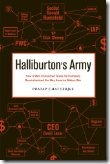 "It's about chocolate covered bunnies." That's how Pratap Chatterjee explained the his new book, Halliburton's Army: How a Well-Connected Texas Oil Company Revolutionized the Way America Makes War. In town for a book tour, we met Wednesday at my local Starbucks to catch-up, but mostly we talked about his book. I have to admit I haven't read it, so I don't know the details but our discussion about the core theme was so intriguing that while he was talking I started talking notes to post a kind of interview with the author.
"It's about chocolate covered bunnies." That's how Pratap Chatterjee explained the his new book, Halliburton's Army: How a Well-Connected Texas Oil Company Revolutionized the Way America Makes War. In town for a book tour, we met Wednesday at my local Starbucks to catch-up, but mostly we talked about his book. I have to admit I haven't read it, so I don't know the details but our discussion about the core theme was so intriguing that while he was talking I started talking notes to post a kind of interview with the author.
For all the debate over how and if the State Department will engage foreign publics, lost in the shuffle is how the State Department remains bureaucratically focused on countries instead of regions. The Department of State must also become the Department of Non-State if it is to be effective in dealing with issues that transcend increasingly quaint ideas of bilateral diplomacy.
Today, as interagency activities between State and Defense increase, the map below highlights a lack of fundamental synchronicity in how each views the world. Of course, the lack of alignment in three critical area – Africa, Middle East, and South Asia – is nothing compared to the different in focus of each Department. Whereas the Defense Department operates predominately regionally, the State Department continues to function at the country level. This is a problem when public affairs officers in one country does not have the same priorities as the PAO in the neighboring country.
State must do more to be a partner, or a leader among equals, to Defense. Resources aside, ranks do not match, which creates problems with responsibilities both within organizations and when speaking to Congress or other organizations.
As collaboration between State and Defense increases, State and Defense must align how they divide up the world and adjust their organizations accordingly. As it is, State should adapt its nineteenth century model to Defense’s model. This means State needs to do some promoting and one elimination. State must get rid of the Under Secretary for Political Affairs and elevate the Assistant Secretaries in charge of each regional bureaus to Under Secretary, making the head of the regional bureau the equivalent of a four-star general and thus a co-equal, by rank, to the Combatant Commander. Whenever a Combatant Commander appears on the Hill, so to should the Regional Under Secretary.
I’ve received some push back on this structure because of the additional reporting to the Secretary of State, but if the Secretary of Defense can have Combatant Commanders report directly to him, why can’t the Secretary of State have Regional Bureaus report directly to here? Let’s flatten the hierarchy and move away from the 19th century alignment. Food for thought: should State instantiate a Joint Chiefs-like entity for an additional advisor?
Sure, Ambassadors would lose some independence as the Bureaus become more powerful as State shifts to a regional view from a country-level view, but this isn’t necessarily a zero-sum. (Side note: regarding Ambassadors, keep in mind that everyone at State and Defense are the President's representative.)
More details to come.
Map Source: http://www.state.gov/documents/organization/65617.pdf. H/T to DF who scored big time finding the above map, a map I was about to bribe DF to create for me.
See also:
- Still Wanted (?): An Under Secretary for Public Diplomacy
- Wanted: an Under Secretary for Public Diplomacy
- Reforming U.S. Public Diplomacy for the 21st Century
- White Oak Recommendations: Rethinking Public Diplomacy
- Informal Summary of 18 Public Diplomacy Reports and their Recommendations by Steven R. Corman
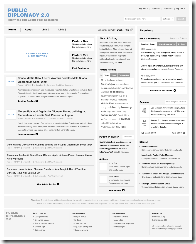 There's a new kid coming to the block: Public Diplomacy 2.0, or PD20.org for short. According to the website, Public Diplomacy 2.0 seeks to
There's a new kid coming to the block: Public Diplomacy 2.0, or PD20.org for short. According to the website, Public Diplomacy 2.0 seeks to
document the use of web 2.0 and social media technologies in the practice of public diplomacy. PD 2.0.org will represent opinions and present examples from a wide range of public and private institutions from around the world. Through interviews with practitioners and thought leaders, analysis of examples in practice, how-to articles, press digests and other sourced and original content, PD 2.0.org's goal is to become a central source for information on Public Diplomacy 2.0.
I'm excited about the launch of this site, and not just because Darren Krape, the one of the project's masterminds, notes they are using my operational definition of public diplomacy:
Public diplomacy 2.0 is the use of new media (web 2.0, social media) to listen, engage and influence foreign publics, either by a government (public diplomacy) or by citizens (citizen diplomacy) in order to create a favorable environment for achieving national security, political, cultural and economic objectives. (Liberally
stolenborrowed from http://mountainrunner.us/2008/11/defining_public_diplomacy.html)
This should shape up to be a significant node in the discourse about the role and utility of social media in what we often call public diplomacy.
This center for discourse would do well to model itself on the community-based Small Wars Journal website and provide fora for discussions, news analysis, knowledge sharing, posting of articles ranging from editorial to journal-length and format, and classifieds.
Check out the working document for the project's roadmap, including possible interviews, features, partnership possibilities, initial taxonomy, etc.
Follow PD20 on the web or on Twitter.
See also this follow up post:
President Obama announced the “White House Internet Team” on Monday. From Ari Melber at The Nation:
Several of the President's "key White House staff," according to a press release from Robert Gibbs, will manage large portfolios for Internet outreach and "citizen participation" online. The list includes several veterans of Obama's presidential campaign, naturally, a former web adviser to Speaker Nancy Pelosi, and a former Google staffer who worked on the company's Moderator platform.
It is noteworthy that the President did call on the Huffington Post in a press conference. Read the whole, brief, article by Melber here.
I doubt they’ll have the same limited agility as State's various “Internet teams”, from America.gov to DipNote to Digital Outreach and beyond.
Speaking of agility, it would be nice to have State’s R, the public diplomacy bureau, not alternating between sitting with palms down on the desk and chasing their tails while wondering if they have a future and if so, what that future will be.
 The Association of Public Diplomacy Scholars at the University of Southern California last week launched their twice-yearly magazine. Titled simply “PD”, the website is http://publicdiplomacymagazine.com/, it is edited by graduate students and published with the support of the USC Center on Public Diplomacy and the USC School for International Relations.
The Association of Public Diplomacy Scholars at the University of Southern California last week launched their twice-yearly magazine. Titled simply “PD”, the website is http://publicdiplomacymagazine.com/, it is edited by graduate students and published with the support of the USC Center on Public Diplomacy and the USC School for International Relations.
According to the website, the publication will “address the challenges and issues of public diplomacy, not only for the United States, but wherever it is relevant in the world.”
Debuting with some serious names (table of contents is below the fold), we hope the magazine remains strong through its second and third issues and beyond.
Calling it a magazine is a bit of stretch considering its publishing schedule, but I know from when we tried to launch the same thing a couple of years ago at USC, there was significant (fatal) resistance to calling it a journal (and we were pushing for 3-4 times a year with classifieds, event calendar, etc.).
This is the only game in town outside of web-only fora for serious public diplomacy articles. The slow production cycle in many ways means the publication is much more like a journal as it means less dynamic and less time-sensitive articles. I’ve already heard from several who wished this wasn’t a semi-annual because they wanted to publish articles but couldn’t wait.
It will be interesting to see the articles in the the next issues as interpretations of public diplomacy by the Association of Public Diplomacy Scholars and the Center on Public Diplomacy will certainly dictate what is published.
 GAO, CRS, academics, and anyone else interested in Public Diplomacy and Strategic Communication must look at Steve Corman’s quick and dirty and most coherent summary ever of eighteen major public diplomacy reports from the most recent White Oak report back to a 2004 Brookings Report.
GAO, CRS, academics, and anyone else interested in Public Diplomacy and Strategic Communication must look at Steve Corman’s quick and dirty and most coherent summary ever of eighteen major public diplomacy reports from the most recent White Oak report back to a 2004 Brookings Report.
The raw numbers don’t tell the complete the story, but that half or more of the reports shared four recommendations is significant.
Somebody, perhaps one of Steve’s student’s, should take this a step further: look at the reports’ definition of public diplomacy and weigh the recommendations accordingly. Is Public Diplomacy an active component in the struggle of minds and wills using “fast” and “slow” communications or a passive informational tool primarily based on the “slow” communications of exchanges?
Either way, Steve’s analysis is unique and the top values are certainly common and yet elusive? Why? Because we had, until last year, no real understanding of the value of people to people engagement after we came out of thirty years of state on state diplomacy followed by the End of History. Congress is eager to help change the system and the Defense Department is eager to help, but will the system, now “owned” by President Obama and Secretary of State Clinton, be changed?
Briefly, a resource some may find useful: Detecting Deception: A Bibliography of Counterdeception Across Time, Cultures and Disciplines by Barton Whaley (edited by Susan Stratton Aykroyd) for the Foreign Denial & Deception Committee of the National Intelligence Council. Less than three years old (March 2006), it is a 676 page (3.1mb) annotated bibliography with brief comments on each entry. It would be nice to have this resource in an electronic database.
The book’s purpose is three-fold:
1) To be the first standard guide to the literature on detection and intelligence analysis in general.
2) To point the reader to those specific writings most useful for analysis, research, development, teaching, or training.
3) To alert the reader to the main competing theories and methods used for analyzing mysteries, particularly where deception is present.
Whaley’s defines deception as
…any attempt—by words or actions—intended to distort another person's or group's perception of reality. And to keep matters simple, a lie is any statement made with the intent to deceive. These definitions avoid confusion with mere misinformation, incomplete information, or the truth value of statements. But they do permit us to include the authorized lies and deceptions practiced with our knowledge and approval by stage actors, magicians, and poker players. Moreover, this definition gets around the worrisome problem of self-deception. Instead, for our present purpose, the target of a deception is not oneself but always another's mind.
Definitely an interesting resource for the engaging in the struggle for minds and wills.
Download the bibliography here (3.1mb PDF).
H/T JMW
The Arab world's (uneven) progress: A knowledge society is budding. But further reform is needed, for the sake of American security, global prosperity, and Arab dignity. by Kristin Lord in The Christian Science Monitor:
Five years ago, the United Nations published the Arab Human Development Report on Building a Knowledge Society. That widely read – and highly controversial – report found a "knowledge deficit" that threatens human development, economic growth, and the future potential of Arab societies. This week the Brookings Institution published a new study, in Arabic, that evaluates what has and has not changed since 2003.
Political instability may dominate the headlines, but advances in education, science, industry, and economic reform also deserve notice. Access to education has expanded markedly over the past five years. Jordan exceeded the international average on eighth grade science scores for the first time ever. New university campuses, including branches of world-class universities in Qatar's Education City, has enrolled more students each year for the past six years. …
Why does this matter? For Arabs, success or failure in building a knowledge society will shape their collective future. It will mean the difference between wealth and poverty, dynamism and stagnation, frustration and hope.
For the United States and the global community, thriving Arab societies bear the promise of less political instability, less anger and despair, and less animosity toward the West. Such societies would export fewer security threats in form of terrorism, economic disruption, and war.
The conversation by Marc Lynch in The National:
The Obama administration now has the opportunity and the ambition to dramatically transform America’s dialogue with the world. But doing so will require a new approach to engaging with the Arab and Muslim world that moves beyond the “war on terror”. American strategy must also transcend the rift that divides present outreach efforts between “strategic communications” and “public diplomacy”. …
But this is not just a battle over resources between the State Department and the Pentagon (though it is also that). It is a battle over concepts. Strategic communications is about control: dominating the information battlefield, shaping the message, defeating the enemy. Traditional public diplomacy is about relationships: building trust, creating networks, establishing credibility. This requires a longer-term outlook, where nurturing a free and independent media in which a variety of voices, friendly and hostile, can compete on an even playing field is more important than momentary tactical information dominance. If American public diplomacy wears combat boots, what does that say about America’s relationship with the world? …
But we need to rethink the foundations of public diplomacy for the new century, just as the American military was forced to rethink its approach in the face of the debacle in Iraq – a process that produced a much-heralded new counterinsurgency field manual for American troops. What would a new field manual for public diplomacy look like?
DOD says decision not final: Flournoy aims to curtail or nix pentagon's public diplomacy shop by Fawzia Sheikh at InsideDefense.com (sub req’d)
During the confirmation process, Flournoy discussed a need to shift some portfolios to better align the office of the under secretary of defense for policy with the policy objectives of Obama and Gates, Pentagon spokesman Lt. Col. Jonathan Withington told ITP in a Feb. 18 e-mail. Changes will not constitute a significant reorganization of the policy shop, but rather "a shifting of responsibilities," Withington stated.
Flournoy plans to discuss potential organizational shifts with internal and external stakeholders before making specific recommendations to Gates, he added. He said details will be unveiled once decisions are reached.
Pentagon and congressional advocates of the DOD public diplomacy office, however, are privately grumbling. A congressional staffer who oversees defense issues told ITP he has heard "rumblings" for the last several days about this possible policy shift on diplomacy. It would be "a big mistake" to follow through with Flournoy's idea, the congressional staffer asserted.
R.I.P. Rob at Arabic Media Shack notes Sudanense author Tayyab Saleh, a titan of Arabic literature, died. Saleh authored the superb, hard to put down Season of Migration to the North: A Novel. It’s a short read which I, and Rob, recommend.
Over the weekend of January 30 through February 1, the Howard Gilman Foundation, Meridian International Center, and The Public Diplomacy Council brought together seventy people - public and private sector stakeholders frustrated with this demise and determined to restore public diplomacy as a viable tool of foreign policy - to discuss the structure of America’s global engagement at the White Oak Conference Center in Florida.
The product of the conference is a short, easily read document of common sense recommendations that would otherwise be in larger reports. All but three of the conference participants endorsed the report. Those who abstained did so because their employers do not permit even personal endorsements. The report is simple and straight forward, so much so that the endorsements run longer than the report.
Download the Recommendations here (26kb PDF).
Download the Endorsements here (84kb PDF).
On February 19, I moderated a sixty minute roundtable discussion between Doug Wilson of the Howard Gilman Foundation and Bob Coonrod of The Public Diplomacy Council. Tara Sonenshine was originally scheduled to attend but had a scheduling conflict at the last minute. The participants were Pat Kushlis of WhirledView, Shawn Powers of Intermap.org, John Brown of PDPBR (and now Notes and Essays), Kim Andrew Elliot of www.kimandrewelliott.com, Steve Corman of COMOPS, Jennifer Bryson of Public Discourse, Chris Tomlinson of the AP, and Danielle Kelton from PD 101.
White Oak-Related posts:
- Nothing New in White Oak Recommendations on Public Diplomacy by Steve Corman
- Reinventing America's Public Diplomacy 2009: Step By Step by Pat Kushlis
- The Conversation by Marc Lynch
- A Proposed Strategy for Public Diplomacy by Spencer Ackerman
- White Oak: We’re going to need a bigger boat (for PD) by Craig Hayden
- A White Oak for Public Diplomacy by Mark Safranski
On the White Oak experience, while I enjoyed the horse riding quite a bit, it was meeting and exchanging ideas with luminaries that was really exciting. I enjoyed talking at length with the likes of Harriet Fulbright and Joe Nye. Latter conversations with Joe included pointing out that his five-point matrix for modern global engagement looks a lot like a pentagon (he laughed).
At the conference, I sat on the “scene setting” panel the first night, which was a bit intimidating. On my left was Harriet Fulbright, the wife of the late Senator Fulbright, and on my right was Barry Fulton, former Associate Director of USIA, with moderator Bob Coonrod, President of The Public Diplomacy Council, and Len Badlyga, former Director of the Office of European Affairs at the USIA, were on the other side of Harriet and Barry, respectively. The gist of the panel, and my wrap-up comments, were the same as the report: there was a time that we understood the importance of public opinion and prioritized and resourced people and activities, including foreign (and even domestic) policies, appropriately. The way forward is surprisingly simple if we step back and look at the foundational issues, which Harriet, Barry, and Len all shared using their own decades of experience.
See also:
- Still Wanted (?): An Under Secretary for Public Diplomacy
- Lies, Damn Lies and Stereotypes by Marc Tyrrell
- Mike Doran’s HASC testimony: Strategies for Countering Violent Extremist Ideologies
- PD is not PR
- Spencer Ackerman’s Future of Public Diplomacy Unsettled at State and Doug Wilson Will Not Be Undersecretary of State for Public Diplomacy
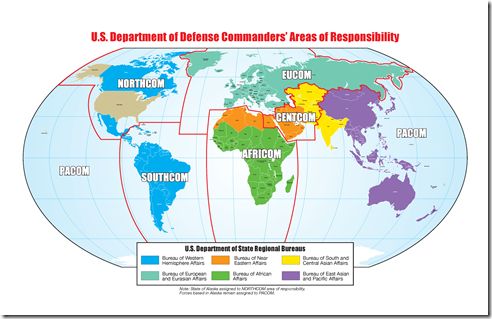


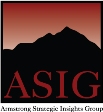
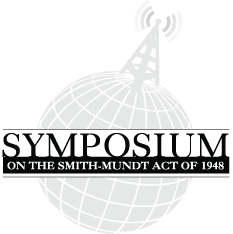
Recent Comments